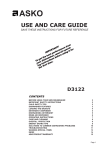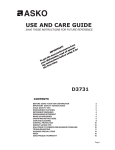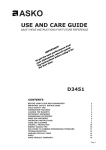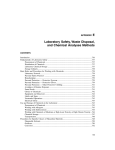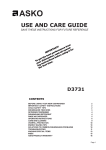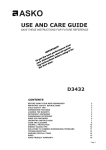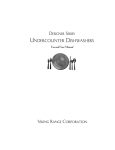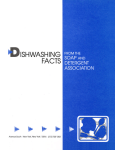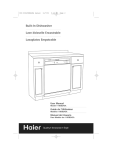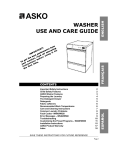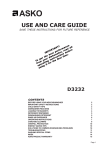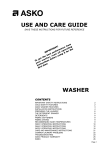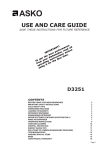Download Asko D3530 Dishwasher User Manual
Transcript
ASKO USE AND CARE GUIDE SAVE THESE INSTRUCTIONS FOR FUTURE REFERENCE rom ! f T e AN nc erat or T a R p f o r m all o g i t PO f r IM in d pe st r, rea re us e b o he a s h e bef t t hw ons ge To r dis ructi . e u yo inst tim t ing fir s the D3530 CONTENTS BEFORE USING YOUR NEW DISHWASHER IMPORTANT SAFETY INSTRUCTIONS CHILD SAFETY TIPS DISHWASHER FEATURES LOADING THE BASKETS DETERGENT DISPENSER DISHWASHING DETERGENT RINSE AID DISPENSER OPERATING INSTRUCTIONS CARE AND CLEANING OVERFILL PROTECTION ENERGY SAVING TIPS SOLUTIONS TO COMMON DISHWASHING PROBLEMS TROUBLESHOOTING WASHING SPECIAL ITEMS INDEX ASKO PRODUCT WARRANTY 2 2 2 3 4 5 5 6 7 10 11 11 11 12 14 15 16 Page 1 BEFORE USING YOUR NEW DISHWASHER ♦ Read through this guide before attempting to use your new dishwasher. ♦ Read the “Washing Special Items” section before washing any porcelain or china that has “on-glaze” decoration, crystal glassware, or items of wood or plastic. ♦ Make sure the door is properly balanced. To do this, open it a little and release it. It should stay where you released it. If it doesn’t, consult the Installation Instructions or contact your installer. ♦ Call your local water company to learn the water hardness in your area. You’ll need to know this to determine how much detergent and rinse aid to use. IMPORTANT SAFETY INSTRUCTIONS This manual does not cover all possible conditions and situations that may occur. Common sense and caution should always be used when installing, operating, and maintaining any appliance. ♦ Read all instructions before using the dishwasher. ♦ Dishwashers must be electrically grounded. Read ♦ ♦ ♦ ♦ ♦ ♦ ♦ ♦ ♦ the Installation Instructions for details. Use the dishwasher only for its intended purpose. Do not run the dishwasher while you are out of the home. Use only automatic dishwasher detergents and rinse agents. To reduce the risk of injury, keep detergents and rinse aids out of the reach of children. Do not load sharp items near the door; you could damage the door seal. Place sharp knives in the silverware basket with the sharp ends down to avoid the risk of cut-type injuries. Do not wash plastic items unless they are marked “dishwasher safe” or the equivalent. For items not marked, check the manufacturer’s recommendations. Items not dishwasher safe could become deformed or melt and create a potential fire hazard. Do not touch the heating element during or imediately after use. Do not operate the dishwasher unless all enclosure ♦ ♦ ♦ ♦ ♦ ♦ ♦ ♦ panels are properly in place (i.e., guard plate, access panel, toe kick, etc.) Do not tamper with controls by removing or changing. Do not abuse, sit on, or stand on the dishwasher door or baskets . To reduce the risk of injury, do not allow children to play in or on a dishwasher. Under certain conditions, hydrogen gas may be produced in a hot water system that has not been used for two weeks or more. HYDROGEN GAS IS EXPLOSIVE. If the hot water system has not been used for two weeks, before using the dishwasher turn on all hot water faucets and let the water flow from each for several minutes. This will release any accumulated hydrogen gas. As the gas is flammable, do not smoke or use an open flame during this time. When removing an old dishwasher from service or discarding it, remove the door to the washing compartment. Do not store or use combustible materials, gasoline, or other flammable vapors and liquids in the vicinity of this or any other appliance. Disconnect electrical power to dishwasher before servicing. Repairs should be done by a qualified technician. CHILD SAFETY TIPS ♦ Dishwasher detergents and rinse aids are corrosive, so always keep them out of reach of children. ♦ Should a child swallow dishwasher detergent or rinse aid, give plenty to drink immediately, i.e., one or two glasses of milk or water. Do not try to induce vomiting. Seek medical advice immediately: 1-800-POISON1 ♦ Always close the door and start the dishwasher as soon as you put in the detergent. ♦ Always keep small children away from the machine when it is open. There may be some detergent residue left inside the machine. Page 2 ♦ If dishwasher detergent gets in someone’s eyes, rinse them with plenty of water for at least 15 minutes. ♦ Do not allow children to use or play in or on the dishwasher. ♦ Load all long and sharp items in the knife/utensil basket. If this is not possible, load sharp objects with the pointed end facing the back of the dishwasher. Sharp items loaded in the silverware basket should be loaded with pointed ends down. DISHWASHER FEATURES NOTE: Deviations in features may occur, depending on the model. Knife/Utensil Basket s m ite e, se hin les rin ac tic to m ar ed the d p ne ad foo d. no lo er e is u g ov e yo lar m er re h re Th fo ug be be ltho uld a ho s Upper Basket Spray Arms Cutlery Basket Lower Basket Detergent Dispenser Rinse Aid Dispenser Filter BASKETS Upper Basket Stemware rack Cup shelf Knife/Utensil Basket Fold-down tines Fold-down glass support bar Knife blade slots Knife stop Plate guard Lower Basket Cutlery Basket Fold-down tines Collapsible handle Cutlery compartments Small items containment lid Easy pull-out handle Page 3 LOADING THE BASKETS Your new dishwasher features ASKO’s Super Cleaning System™. This means that after prewash, mainwash and intermediate rinse the water is drained out and cycle continues with clean water. If you plan to start your dishwasher right away, it’s not necessary to rinse the dishes. You do, however, need to scrape off the large particles of food before loading. LOADING THE UPPER BASKET After you have scraped off the large food particles, place glasses, cups, saucers, bowls and small plates in the upper basket, as illustrated. Load stemware with the stem fitted inside one of the grooved tines on the stemware rack. The row of tines by the stemware rack is adjustable to prevent glassware from bumping together (clattering). Load the glassware then use the lever to adjust the tines until the items are secure. The fold-down cup shelf on the right side of the basket gives you an additional place to stack cups and small bowls. The cup shelf is divided, which gives you more loading flexibility. This model has a knife stop on the front of the upper basket and special slots to hold the blades securely in place. This gives you a safe place to load long utensils and knives that won’t fit in the silverware or knife/ utensil basket. The knife stop prevents knives or utensils from damaging the door when you open and close it. NOTE: When loading sharp items, always be careful not to cut the rack coating. LOADING THE KNIFE/UTENSIL BASKET Whenever possible, knives and long utensils should be loaded in the knife/ utensil basket attached above the upper basket. To avoid injury, items with sharp ends should always be loaded with the sharp ends pointed toward the back of the dishwasher. Again, always be careful not to cut the rack coating when loading sharp items. LOADING THE LOWER BASKET Load larger items in the lower basket, such as, dinner plates, pots and pans, serving dishes, and casseroles. The rear tines easily fold down to provide space for large items, such as pots and pans. Be sure to load dishware facing downward or toward the center of the dishwasher. The plate guard on the bottom front of the upper basket (see page 3) is designed to prevent you from loading dishes in the lower basket that are too tall and could interfere with the spray arm rotation. If an item strikes the plate guard when you slide the lower basket into the dishwasher, it should be removed or rearranged. LOADING THE SILVERWARE BASKET The silverware basket is designed with eight compartments to help keep the silverware separated. Load silverware with the handles downwards and spread it out as much as possible to avoid nesting. For safety, load sharp knives with the handles up. Avoid placing silverware made of different materials (e.g., silver and stainless) in the same compartment because of the risk of discoloration. (See page 15.) Small Items Containment Lid The silverware basket has a lid in the middle that snaps down over the compartments to its left or right to contain small, lightweight items that might slip through the rack tines or get washed out of the basket. The small items lid is slotted, so you also could use it to keep silverware separated, such as teaspoons. Page 4 Small items containment lid When loading silverware, try to avoid nesting the spoons and forks. DETERGENT DISPENSER ASKO dishwashers are designed to be energy efficient. Because the machine uses less water than conventional dishwashers, you also use less detergent and rinse aid. Generally, only one tablespoon of detergent is needed for a normal wash load. The amount of detergent needed for your dishes, however, could be more, depending on the hardness of the water in your area. Also, more heavily soiled items need more detergent. (See below.) Measure and place detergent for the main wash into the large detergent compartment. The detergent for prewash goes into the small compartment to the right of the main wash compartment. You should use one-half the amount of detergent for the prewash that you use for the main wash. The amount of detergent used for the main wash and prewash combined should never be over three tablespoons. Always add the detergent just before starting the dishwasher, otherwise it could get damp and won’t dissolve properly. Prewash Detergent Compartment Dispenser Lid Lever Rinse Aid Level Indicator Main Wash Detergent Compartment Rinse Aid Compartment Detergent Compartment Lid WARNING! Dishwasher detergent is corrosive! Take care to keep it out of reach of children. NOTE: We recommend that you do not add prewash detergent for Quick or Delicate wash programs. DISHWASHING DETERGENT We recommend that you use only unscented, granular automatic dishwashing detergent. Using the wrong detergent could cause flooding and/or damage your dishwasher. Do not use detergent that has been wet and is clumped. Also, check the expiration date on the container. The amount of detergent needed can vary due to differences in water hardness. To determine the water hardness in your area, contact your local water utility or area water softening company. The harder the water, the more detergent you may need. Refer to the chart below for the recommended detergent amounts based on water hardness. Remember, you should adjust the amount of detergent you use by small amounts until you find the correct amount. NOTE: We recommend that you do not add prewash detergent for the Quick or Delicate wash programs. NOTE: If you use a dishwashing detergent with a rinse aid additive, you should not fill the rinse aid dispenser. This could cause a film on your dishes. RECOMMENDED DETERGENT AMOUNTS BASED ON WATER HARDNESS WATER HARDNESS Soft (0-3 grains per gallon) Medium (4-8 grains per gallon) Hard (9+ grains*) DETERGENT AMOUNTS Prewash Main wash Prewash Main wash Prewash Main wash 1 1 1 1 1 2 teaspoon to 1-1/2 tablespoons teaspoon to 2 tablespoons teaspoons to 3 tablespoons * 12 grains and higher is extremely hard water. See below for more details. Twelve grains and higher is extremely hard water and detergent alone may not be enough. You may need to use a water softener to maximize the performance of your dishwasher. Also, in areas with extremely hard water (9+) you may need to wash at lower temperatures to prevent hard water deposits from forming in tank and wash system. In hard water areas, both the dishes and the machine can develop a white or gray film after a while. This can be removed by replacing the prewash detergent with two tablespoons of citric acid. If the water is very hard, use a rinse aid that contains citric acid. Different brands of dishwasher detergent have different amounts of phosphorous for softening water. If you have hard water and use a detergent with less than 8.7% phosphorous content, you may need to use more detergent or use a detergent with more than 8.7% phosphorous content. Page 5 RINSE AID DISPENSER The rinse aid is released during the final rinse to prevent water from forming droplets on your dishes that can leave spots and streaks. It also improves drying by allowing water to “sheet” off the dishes. ASKO dishwashers are designed to use liquid rinse aids. The rinse aid dispenser is located inside the door next to the detergent dispenser. (See illustration on page 3.) To fill the dispenser, open the cap and pour the rinse aid into the dispenser until the level indicator turns completely black. The dispenser holds about four ounces of liquid rinse aid. Be careful not to overfill the dispenser, because this could cause oversudsing. Wipe away any spills with a damp cloth. Don’t forget to replace the cap before you close the dishwasher door. If you have soft water, rinse aid may cause a white film to develop on your dishes. You may not need rinse aid. NOTE: Open Closed Dispenser Cap 1. To open the dispenser, turn the cap to the “open” (left) arrow and lift it out. 2. Pour the rinse aid into the dispenser, being careful not to overfill. 3. Replace the cap by inserting it aligned with “open” arrow and turning it to the closed (right) arrow. If you use a dishwashing detergent with a rinse aid additive, you should not fill the rinse aid dispenser. This could cause a film on your dishes. ADJUSTING THE AMOUNT OF RINSE AID DISPENSED A measured amount of rinse aid is released during the final rinse. As with detergent, the amount of rinse aid needed for your dishes depends on the hardness of the water in your area. (See page 5.) Too much rinse aid can result in lather or foaming and cause cloudiness or streaks on your dishes. If the water in your area is very soft, you may not need rinse aid. If you do, you can dilute the rinse aid with an equal amount of water. The rinse aid dispenser has six settings. Always start with the dispenser set on “1.” If spots and poor drying are problems, increase the amount of rinse aid dispensed by removing the dispenser lid and rotating the dial to ”2.” If the dishes still aren’t drying properly or are spotted, adjust the dial to the next higher number until your dishes are spot-free. To increase the amount of rinse aid released in the final rinse, turn the adjustment dial to the next higher number. Rinse aid adjustment dial NOTE: Only adjust the dial one number at a time. WHEN TO REFILL THE RINSE AID DISPENSER The black dot on the rinse aid dispenser indicates the amount of rinse aid in the dispenser. As the rinse aid diminishes, the size of the black dot decreases. You should never let the rinse aid get below 1/4 full. Rinse Aid Level Indicator As the rinse aid diminishes, the size of the black dot on the rinse aid level indicator changes, as illustrated below. Full 3/4 full 1/2 full 1/4 full - Should refill to eliminate spotting Empty RINSE AID INDICATOR Model D3530 has an indicator on the control panel that displays when the rinse aid dispenser is nearly empty. After you refill the dispenser, there may be some delay before this indicator goes out. Page 6 OPERATING INSTRUCTIONS THE CONTROL PANEL Your ASKO dishwasher has our state-of-the-art electronic control panel, as illustrated below. SET S TA R T PROG STOP MENU PC-UPGRADE Program button Display window Programming buttons Start/Stop button DISPLAY WINDOW The display window shows the programs, options, remaining program time and fault codes. It also allows you to access the program menus and customize the wash programs. If you select Delayed Start, the window will display the number of hours selected. When you press Start/Stop, the countdown time displays. Remaining program time – The remaining program time is calculated by the time it took the program to run last time. (Note: The first time you run a program, the display will display 1:00.) As the program progresses, the time remaining displays the hour and minutes (e.g., 1:02, which means one hour and two minutes.) PROGRAMS To select a program, simply press the program button until the program you desire displays then press Start/Stop. The programs are described below. You can also change certain program features. See “Options” below. Auto Wash Lower Basket The dishwasher has sensors that detect the level of soil Washes only the lower basket on the dishes and adjust the water consumption and Delicate Wash (Cold, 140° F) temperature accordingly. You cannot adjust the For delicate items, such as fine china and crystal, that temperature or drying time with this program. are washed immediately after use. When using this Heavy Wash (Cold, 85° – 170°/Sani F) For the heaviest soiled loads, such as casseroles or sauce pans. Normal Wash (Cold, 85° – 170° F) For normally soiled loads, such as plates, glasses, bowls, and lightly soiled pans. Mixed Wash Designed to wash heavily soiled dishes in the lower basket and lightly soiled dishes in the upper basket. Upper Basket Washes only the upper basket program, you should set the temperature to low and dry the dishes without heat. Quick Wash (Cold, 85° – 140° F) For lightly soiled loads that are washed immediately after use. This program can also be used for delicate items, but you should set the temperature to low and dry the dishes without heat. Rinse and Dry (120° F) Rinses the dishes with hot water then activates the fan and heating element to dry them. Rinse and Hold To rinse dishes that you plan to wash later that day. OPTIONS Once you have selected a program, you can change some of the program features by using the options (described below). To select an option, simply press the Menu button until the option you desire displays, then press the Set button until the desired setting displays. Press Menu to confirm your selection. You can continue to make programming changes or press Start/Stop to start the program. Delayed Start This option allows you to delay starting the dishwasher from 1/2 hour to 24 hours. Press the Menu button until Delayed Start displays, then press Set until the number of hours you wish to delay starting the dishwasher displays along with a flashing clock symbol. Press Menu then press Start/Stop. To cancel Delay after you press Start/Stop, hold down the Start/Stop button for three seconds. If you change your mind before you press Start/Stop, continue to press this button until “0” displays. All Baskets This option lets you set which spray arms will function. You have three choices: All Baskets – Washes both the upper and lower baskets Upper Basket – Washes only the upper basket Lower Basket – Washes only the lower basket Temperature The temperature can be changed in all programs, except Auto wash, Rinse and Hold, and Rinse and Dry. Your choices are: cold, 85°, 105°, 120°, 130°, 140°, 160°, and 170° F. (Note: The Delicate and Quick wash programs cannot be set over 140° F.) To select a temperature, press the Menu button until Temperature displays, then press the Set button until the desired setting displays. Press Menu to confirm your selection. When you select 170° F, the word “Sani” displays. Options continued on next page... Page 7 OPTIONS, CONTINUED Drying This lets you select how long the turbo fan runs after the final rinse. You have three options: Short, Normal, or Extra drying. (Note: This option is not available with the Auto wash, Rinse and Hold, and Rinse and Dry programs.) To set the drying time, press Menu until “Drying” displays, then press Set until your preference displays. Express This option reduces the wash time and lowers the wash temperature by 20° F. (Note: This option is not available with the Quick Wash and Rinse and Hold/Dry Programs.) Press Menu until Express displays, then press Set once to select On or twice to select Off. Press Menu to confirm your selection. Cool Touch This option lets you set a cool-down cycle after the drying program. Press Menu until Cool Touch displays, then press Set once to select On or twice to select Off. Press Menu to confirm your selection. START/STOP BUTTON Once you have selected the wash program and options, press this button to start the dishwasher. (Make sure the door is securely closed.) PROGRAM TIMES The program times may not always be the same because of variations in the household hot water temperature. The dishwasher heats the water to the proper temperature for the program selected; so if the temperature of the water entering the dishwasher is too low, the dishwasher will run longer because it takes longer to heat the water. Raising your water heater setting could help to shorten the cycle times. INTERRUPTING A PROGRAM TO ADD AN ITEM If you want to interrupt a program to add an item, open the door slightly until the spray arms stop turning. You can then open the door fully and place the item into the dishwasher. Close the door securely. The program will continue from where it was interrupted. WARNING! Be extremely careful when opening the door during a program. The water is hot and you could get scalded. CHANGING OR STOPPING A PROGRAM If you decide to change the program after you have started the machine, press the Start/Stop button for three seconds. You will have to select the program and options again when you are ready to restart the program. (Note: If the program has already gone through the wash cycle, you will have to add detergent.) FAULT CODES In the event that the machine should fail during a program, the display window will show a fault code. The table below defines these codes and gives possible causes and solutions. See also “Troubleshooting” on page 13. If you have corrected the fault, turn the main power off then back on to remove the fault indication. If it still displays, try again to correct the problem or call a service technician. Display Type of Fault and Recommended Action Overfilling Too much water has entered the dishwasher. Call a service technician. Water Inlet Fault Water inlet fault. Make sure the water supply is open. Inlet Valve Leakage Valve leakage. Shut off the water supply and contact a service technician. Drainage The drain is blocked. See “Troubleshooting” on page 13. Blocked Filter The filter is clogged. See “Cleaning the Filters” on page 10. Page 8 SPECIAL SETTINGS MENU Model D3530 has several special settings available, as defined below. To access them, press the Menu button until “Special Settings” displays then press Set. Activating the Child-Safe Button Language To set the child lock feature, follow the steps below: You can change the language in the display window to one of the following: English Swedish French Danish Spanish Norwegian Russian Netherlands Italian Finnish To change the language, follow the steps below: 1. Press Menu until “Special Settings” displays then press Set. 2. Press Menu again until “Language” displays. 3. Press Set until your language choice displays. 4. Press Menu to confirm your selection. End-of-Program Buzzer Volume At the end of each program, a buzzer sounds. You can adjust the volume of the buzzer as follows: 1. Press Menu until “Special Settings” displays then press Set. 2. Press Menu again until “Buzzer” displays. 3. Press Set until your volume preference displays. Your choices are 1 (softest) to 9 (loudest). A “0” indicates the buzzer is off. 4. Press Menu to confirm your selection. Celsius or Fahrenheit You can change the temperature on the display window from Celsius to Fahrenheit and vice versa. To do this, follow the steps below: 1. Press Menu until “Special Settings” displays then press Set. 2. Press Menu again until “°C” or “°F” displays. 3. Press Set until your preference displays. 4. Press Menu to confirm your selection. This model can be programmed not to start unless the Start button is held down for three seconds. 1. Press Menu until “Special Settings” displays then press Set. 2. Press Menu again until Child Lock displays. 3. Press Set to turn the feature on. 3. Press Menu to confirm you change. A key symbol appears in the display when the child lock is active. To deactivate the child lock, press the Set and Menu buttons simultaneously. You can then select the program and options and press Start to start the unit. The child lock comes back on automatically after three minutes. To permanently deactivate the lock, repeat the above steps. Machine Information You can view how much water the machine used the last time it was operated and how many times it has been used since it was new. To do this, follow the steps below. 1. Press Menu until “Special Settings” displays then press Set. 2. Press Menu again until “Machine Information” displays. 3. Press Set to view the water usage (in litres). 4. Press Set again to view the number of times the machine has been used. 4. Press Menu to exit. RESTORING FACTORY-DEFAULT SETTINGS You can easily restore the factory default settings (except language) by following the steps below: 1. Turn off the power. Wait approximately 5 seconds. 2. Hold in the Program button while pressing the main power button. Page 9 CARE AND CLEANING The interior of your ASKO dishwasher is made of surgical quality stainless steel that has been electropolished to make it the smoothest surface available. The smooth surface prohibits the accumulation of dirt and bacteria inside the unit. If the water in your area is especially hard, however, lime deposits could form inside the machine. If this happens, you can remove them by putting two tablespoons of citric acid in the detergent compartment and running a Normal program. In extremely hard water areas you may need to repeat this process a few times to remove hard water deposits. CLEANING THE FILTERS For your convenience, we have placed the drain pump and filtering system within easy reach inside the tub. There are three components of the filtering system: the main filter, the coarse filter, and the fine filter. In hard water areas, it may be necessary to clean chemical buildup from the filters every 12 to 18 months. To do this, remove the coarse filter by squeezing the tabs and lifting it out. Next, unscrew the fine filter and lift it and the main filter out. Wash all three filters gently in hot, soapy water and rinse them thoroughly. WARNING! Never run the dishwasher without the filters in place. Main filter Food and soil particles trapped by this filter are pulverized by a special jet on the lower spray arm and washed down the drain. Fine filter This filter holds soil and food residue in the sump area and prevents it from being redeposited on the dishes during a cycle. Coarse filter Larger items, such as pieces of bone or glass, that could clog the drain are trapped in the coarse filter. To remove an item caught in this filter, gently squeeze the tabs on top of this filter and lift it out. CLEANING THE DOOR To clean the edge around the door, use only a soft warm, damp rag. To prevent penetration of water into the door lock and electrical components, do not use a spray cleaner of any kind. Also, never use abrasive cleaners or scouring pads on the outer surfaces because they will scratch the finish. Some papers towels can also scratch or leave marks on the surface. WARNING! Never use a spray cleaner of any kind on the door panel. You could damage the door lock and electrical components. And never use abrasive cleaners or scouring pads on the outer surfaces because they will scratch the finish. Also, some paper towels can scratch or leave marks on the stainless steel surface. CLEANING THE DRAIN PUMP On occasion something may get through the filters and into the drain pump. The drain pumps on ASKO dishwashers are designed to automatically reverse if anything should get caught in the propellers, thus ejecting the item back into the sump area or down the drain. Should you need to remove an obstacle from the drain, first turn the power off then remove the filters (as explained on page 7). Next, lift out the adaptor piece on the left side of the sump area. (You might want to remove any standing water first.) You can then look into the sump area for the item causing the obstruction. You may need to use your finger to move the pump blade and loosen the object. Should you find something, simply scoop it out then replace the adaptor piece and the filters. To reach an item caught in the drain pump, remove the filters then the small black insert in the sump area. WARNING! Never run the dishwasher without the filters in place. WARNING! Be sure to replace the adaptor piece before you put the filters back in. Page 10 OVERFILL PROTECTION Your ASKO dishwasher has an overfill protection device that automatically shuts off the inlet valve and circulation pump and starts the drain pump if the water level in the unit should rise above the normal level. If this happens, turn the water off at the main supply and call for service. If there is water in the base pan due to an overfill or small leak, the water must be removed before the dishwasher will start. When an overfill is detected, the display window will show a fault message. (See “Fault Codes” on page 8.) ENERGY SAVING TIPS ♦ If you plan to wash the dishes right away, there’s no need to pre-rinse. Simply scrape off large particles and load the dishes. ♦ Wash only full loads. ♦ Use the Auto Wash program whenever possible. ♦ Use the Heavy Wash program only for heavily soiled dishes. ♦ Don’t use temperatures above 130°F for lightly soiled dishes. ♦ Select the upper or lower basket program or option when only one basket is loaded. ♦ Use the Express option when washing only slightly soiled loads. ♦ Use the “Short” drying option. (You can speed up the drying process by opening the door slightly to release the moist air.) SOLUTIONS TO COMMON DISHWASHING PROBLEMS As with any new appliance, it sometimes takes using it a few times to learn to operate it properly. If you are having minor performance problems with your dishwasher, read this section before calling for service. It may save you time and unnecessary expense. Poor washing performance ♦ The dishes may not be loaded properly. Make sure that soiled surfaces are facing downward or toward the center of the dishwasher. Also, make sure that the bowls, pots, etc., are not stacked so closely that water can’t reach the soiled surfaces. ♦ Make sure you are using the appropriate program settings for the dirtiness of your dishes. ♦ An item may be obstructing the spray arm rotation. With the baskets loaded and in place, manually turn the spray arms to make sure they move freely. ♦ Your dishwasher detergent should be fresh and stored tightly closed in a cool, dry place. Old or caked detergent will not dissolve properly. Wait until you are ready to start the dishwasher to add the detergent. If you are using the Delay program, make sure the dispenser is dry before adding the detergent. ♦ Your dishwasher detergent may be inferior. Try a different brand. ♦ Make sure the rinse aid dispenser is filled. (See page 6.) ♦ If you have hard water in your area, try adding more detergent and increasing the amount of rinse aid dispensed. (See page 5.) ♦ Check that the spray arm jets are not clogged. ♦ Do not overload the dishes and be careful to avoid nesting. Poor drying performance ♦ Select the Extra Dry setting. ♦ If you don’t want to use Extra Dry, you can decrease the drying time by opening the door slightly to let out the warm, humid air. ♦ Make sure the rinse aid dispenser is filled. (See page 6.) ♦ Make sure you use the proper amount of rinse aid. (See page 6.) NOTE: ASKO has no control over what is put in our appliances once installed in a customer’s home. You are solely responsible for what you wash in your ASKO dishwasher. ♦ Load items with concave bottoms tilted so as much water as possible will run off. ♦ Unload the bottom basket first to avoid spilling water onto the dishes when unloading the top basket. ♦ Certain plastics may need to be towel dried. Plastic items ♦ Always check the manufacturer’s suggested care instructions before washing plastic in your dishwasher. ♦ Some high-acid foods can discolor plastic. You should rinse these items if you do not plan to run the dishwasher right away. ♦ Plastic items dry poorly and may need to be towel dried. Chipped or Broken Dishes ♦ When you load the dishes, be sure they’re securely in place and will not fall over or strike against each other during the wash. ♦ Load glasses between the tines, not straddling them. ♦ Move the baskets in and out slowly to avoid slamming the dishes together. ♦ Make sure not to load dishes so high that the spray arms could strike them. ♦ Make sure tall glasses and stemware will clear the top of the tub when you push the basket in. ♦ Always load delicate items in the top basket. ♦ Do not overload the dishwasher. ♦ Do not jam the glasses together when loading. Continued on next page. Page 11 SOLUTIONS TO COMMOND DISHWASHING PROBLEMS, continued Stains and discolorations Etching Stains or discoloration on dishes could be caused by a number of things. Listed below are some of the most common causes. See also “Washing Special Items” on page 15. If you have a cloudy film on your dishes that can’t be removed, it could be etching. To prevent etching, try the following: ♦ Too much iron or manganese in the water can cause yellow or brown marks on your dishes. As a temporary solution, in place of the prewash detergent, use one teaspoon to one tablespoon of citric acid crystals. You should consider installing a water filtering system. ♦ Coffee and tea stains usually have to be removed by handwashing in a solution of 1/2 cup bleach and one quart of water. (Do not use on sterling silver or silver plate.) Be sure to rinse these items thoroughly before putting them in the dishwasher so there is no bleach residue on the dishware. ♦ Use less detergent. You may be using too much for the water hardness in your area. (See page 5.) ♦ Use a good quality dishwasher detergent. ♦ Do not overload the machine. Water should circulate freely to ensure adequate rinsing and draining. ♦ Fill the rinse aid dispenser (unless you have soft water in your area; in which case you may not need a rinse aid). (See page 6.) ♦ Use a lower water temperature setting. ♦ Do not use the Extra Dry setting. ♦ Do not pre-rinse the dishes; just scrape off large food particles and bones. REMOVING HARD WATER SPOTS FROM DISHES To remove hard water spots, try the following: bottom rack of the dishwasher. 1. Run dishes through a normal wash program. 4. Run the dishes through a Normal wash program. 2. Remove all metal dishware, such as cutlery, pans, etc., from the dishwasher. If this doesn’t work, try the same process with 1/4 cup of citric acid crystals (available at most drug stores) instead of vinegar. 3. Do not add detergent. Instead, pour two cups of vinegar into a bowl and set the bowl face up on the TROUBLESHOOTING If you should experience a problem with your dishwasher, you should review the list of frequently encountered situations below. It could save you the cost and inconvenience of a service call. Even though the product is under warranty, if the problem is not caused by defective product workmanship or materials, you will be charged for a service call. Refer to page 17 to determine what is and is not covered under your warranty. If you’re still not sure, contact the ASKO Advisory Center before you call a service technician. Type plate (see below) BEFORE YOU CALL Before calling for service or contacting ASKO regarding a warranty issue, make a note of the model name, type number and serial number. The model is on the front of the dishwasher. The type plate with the type name and serial number is located on the inside edge of the door. (See illustration at right.) Type Name Type: DW20.X ASKO Advisory Center Phone Number: 972-238-0794 or 800-898-1879 Continued on next page. Page 12 123456789012345678 123456789012345678 123456789012345678 000000000000 12-digit Serial Number TROUBLESHOOTING, continued Detergent left in compartment Dishwasher does not drain properly ♦ The dispenser is not supposed to open when you use the Rinse program. ♦ Your dishwasher detergent should be fresh and stored tightly closed in a cool, dry place. Old or caked detergent should be thrown away because it will not dissolve properly and will leave a gritty residue on the dishware. ♦ If the unit is connected to a garbage disposer, make sure the disposer is empty. ♦ Be careful not to load items so close to the dispenser that the cover will not open to release the detergent. ♦ Wait until you are ready to start the dishwasher to add the detergent. ♦ If you are using the Delay program, make sure the dispenser is dry before adding the detergent. ♦ The detergent compartment only opens in the main wash programs, not the Rinse program. Dishwasher makes unusual noises ♦ This usually means that something is not loaded properly. Make sure the dishes are securely in place and that nothing has fallen between the basket tines. Also, place small items in the small items compartment and close the lid. (See page 4.) Dishwasher leaks ♦ Use only unscented, granular automatic dishwasher detergent. Using a liquid detergent could cause oversudsing and leakage. ♦ You should always use fresh detergent. ♦ The amount of detergent needed for your dishes depends on the hardness of the water in your area. Contact your local utility company to learn the water hardness in your area then refer to the chart on page 5 to determine the amount of detergent you should use. ♦ Be careful not to overfill the rinse aid dispenser. Spilled rinse aid could cause oversudsing and lead to overflowing. Wipe away any spills with a damp cloth. ♦ Make sure that the cycle was complete before you opened the dishwasher. If not, allow it to complete and check again. ♦ Some water left in the sump area near the drain is normal. ♦ If the plumbing code in your area requires an air gap, make sure that the air gap isn’t blocked or plugged. ♦ If water backs up into the sink, check the garbage disposer and trap for blockage. ♦ Check the dishwasher filters and drain area for blockage. (See page 10.) ♦ Check for a kink in the drain hose. Dishwasher does not fill properly ♦ Make sure the water supply is turned on. ♦ Check inlet-valve. ♦ Make sure the dishwasher is turned on and the door is closed securely. ♦ Check for crimps in the water feed line. ♦ The system is designed to detect an overflow. When it does, it shuts off the circulation pump and inlet valve and turns on the drain pump. (See “Overfill Protection” on page 11.) Dishwasher will not start ♦ Make sure the dishwasher is turned on and the door is closed securely. ♦ Make sure the Delay option is not turned on. ♦ Check that the water supply is connected properly and the water is turned on. ♦ Make sure the power cord is properly plugged into the wall socket. ♦ Check your fuse box for a blown fuse or tripped circuit breaker. ♦ Make sure the dishwasher is level. (See the installation instructions.) Dishwasher runs too long ♦ If the temperature of the water entering your dishwasher is below 120°, the dishwasher runs longer because it heats the water to the proper temperature for the program selected. Raising your water heater setting may help to shorten the cycle times. If this doesn’t resolve the problem, call the ASKO Advisory Center. Page 13 WASHING SPECIAL ITEMS Material Aluminum Dishwasher Safe had any affect on it. NOTE: ASKO has no control over what is put in our dishwashers once installed in a customer’s home. You are solely responsible for what you wash in your ASKO dishwasher. Information and Recommendations Yes, with caution Anodized aluminum may fade or darken. Patches and discoloration may appear, but they can be removed with steel wool. Load aluminum utensils (such as a pie tin or roasting pan) where they do not touch other dishes because this can cause gray or black marks. You can remove these spots with a nonabrasive cleaner. Cast Iron No The seasoning is lost and the iron rusts. Hand wash and dry immediately. China Yes, with caution China without decoration or with decoration protected by glaze is dishwasher safe. However, you should arrange the objects so they do not touch each other or they could be damaged. China with a pattern on top of the glaze or with gold leaf decoration may fade. If possible, check with the manufacturer. If that isn’t possible, wash one item over an extended period then compare it with the colors and patterns of the rest of the set. Wash in the Quick program on a low temperature setting. Copper Yes, with caution Do not wash copper in the same load as silver or silver plate. It could discolor the silver items. Do not let copper items come in contact with stainless steel. Crystal No Antiques and very delicate china should not be washed in the dishwasher. Certain types of lead crystal may etch if machine washed. Check with the manufacturer. Yes Wash at a low temperature setting. Be sure to load crystal dishware so that it is secure and will not fall over or knock against other dishware while being washed. Dirilyte No Gold-colored flatware can become discolored. Disposable plastic items No Cannot withstand machine washing. Flatware with bonded handles No Certain types of adhesives may loosen when machine washed. Glass Yes Exception: Milk glass may turn yellow. Knives No Sharp kitchen knives may become dull if washed in very hot water and allowed to contact other items during the wash. Wood handles may also warp, crack, or loosen. Plastic handles may discolor. Check manufacturer’s washing instructions. Lead crystal No Certain types of lead crystal may etch if machine washed. Non-dishware items No Never wash items such as electronic air cleaners, air filters of any kind, paint brushes, etc. You could damage the dishwasher. Non-stick coatings Yes If marked “Dishwasher Safe.” After washing, wipe the non-stick coating area with vegetable oil to maintain its non-stick quality. Pewter No Pewter will tarnish when machine washed. Plastic Yes If the item is labeled dishwasher safe. Do not use Extra dry. Do not wash disposable plastic items. Silver and Silver plate Yes, with caution Rinse these items if you’re not going to wash them immediately; salty or acidic foods can stain if left on. Dry dishwasher detergent can produce black marks which are difficult to remove. Do not put silver and silver plate in the same silverware basket with stainless steel. Contact between these metals can damage silver. Do not wash copper utensils in the same load. This could cause a brown film on the silver. Also, adhesives used to attach some hollow-handled knives can loosen. Stainless Steel Yes, with caution Rinse these items if you’re not going to wash them immediately; salty or acidic foods can stain if left on. Dry dishwasher detergent can produce black marks which are difficult to remove. Do not mix different types of stainless steel in the same load. Tin No Tin will rust. Wood No Unless marked “Dishwasher Safe” by the manufacturer. Wood can warp, crack or lose shape with any kind of washing. Page 14 ENGLISH Most common dishware items can be safely washed in an automatic dishwasher. If you have any doubts about a particular item, check with the manufacturer to see if it is dishwasher safe. If that isn’t possible, you might wash one item of a set a few times and compare it to the rest of the set to determine if washing it in the dishwasher INDEX A Adding a program Auto wash L 9 7 B Buzzer 10 9 8 8 10 11 7 D Default settings, restoring Deleting a program Detergent dispenser Detergent left in compartment Dishwasher does not drain properly does not fill properly features makes unusual noises runs too long Dishwashing problems Display window Door, cleaning Drain, problems Drain pump, removing an obstacle 9 9 3 13 13 13 3 13 13 11 7 10 13 10 E End-of-program buzzer Energy saving tips Error codes Etching 9 11 8 12 F Factory-default settings, restoring Fahrenheit or Celsius in display window Fault codes Fill problems Filtering system Fine filter Flatware with custom handles 9 9 8 13 10 10 14 5 12 I Interrupting a program to add an item Machine information Main filter Main wash detergent compartment 9 10 5 O Operating instructions Options 7 7 P Pre-wash detergent compartment Program options Program times Programs adding a deleting a 5 7 8 7 9 9 R Restoring factory-default settings Rinse aid dispenser 9 6 S Serial number location Service Silverware basket Small items compartment Solutions to problems Special settings menu Spray Arms Stains and discolorations Start/Stop button Stemware rack Stopping a program 12 16 4 4 11 9 3 12 8 3 8 T Troubleshooting Type plate location on unit 12 12 U Unusual noises Upper basket Utensil/knife basket 13 3 4 V Warranty information H Hard water removing spots 9 3 M 9 C Care and cleaning Celsius or Fahrenheit Changing or stopping a program Child-safe button feature Coarse filter Common dishwashing problems Control panel Language display Lower basket 16 W Wash programs Washing special items Water hardness 7 14 5 8 K Knife stop Knife/Utensil basket Knives 4 4 14 Page 15 ASKO PRODUCT WARRANTY MODEL D3530 Be sure to complete the Warranty Registration Card you received with your appliance and mail it to AM Appliance Group to validate your appliance warranty. Cosmetic damage must be reported to your dealer within five days from the date of purchase. After unpacking the dishwasher, thoroughly check the unit for cosmetic damage. FOR RESIDENTIAL INSTALLATIONS ONLY LENGTH OF WARRANTY AM APPLIANCE GROUP WILL PAY FOR: ASKO replacement parts and/or repair labor to correct defect in Three-Year Full Warranty From date of purchase. materials or workmanship. Service must be provided by an authorized ASKO service agent. Fourth & Fifth Year Limited Warranty ASKO replacement parts (not including labor) for any defective solidstate controls, timers, motors, or pumps as well as defective dishwasher racks – does not include damage due to misuse or abuse. Service must be provided by an authorized ASKO service agent. Three year full plus fourth and fifth year limited from date of purchase. Lifetime Warranty ASKO replacements parts (not including labor) of the stainless steel tank or inner door panel if it fails to hold water due to a manufacturing defect, such as rusting or cracking. Service must be provided by an authorized ASKO service agent. FOR NON-RESIDENTIAL INSTALLATIONS Six-Month Full Warranty From date of purchase. ASKO replacement parts and/or repair labor to correct defect in materials or workmanship. Service must be provided by an authorized ASKO service agent. AM APPLIANCE GROUP WILL NOT PAY FOR: A. Service calls to: 1. 2. 3. 4. 5. Correct the installation of the appliance. Repair damage due to shipment, delivery, installation, misuse or abuse. Instruct how to use the appliance. Replace house fuses or correct house wiring. Correct house plumbing, including drain problems related to improper installation. (High loop, disposer knockout, disposer not draining, etc.) 6. Clean or service air device in drain line. B. Repair and/or replacement parts for failure of product if appliance is used for other than home/residential use. C. Damage resulting from accident, fire, floods, acts of God, alteration, misuse, abuse, improper installation, or installation not in accordance with local electrical or plumbing codes. D. Any shipping costs for parts during the limited warranty period. E. Replacement parts or repair labor costs for units operated outside the Continental United States. F. Pickup and delivery. ASKO washers are designed to be repaired in the home. IN NO EVENT SHALL AM APPLIANCE GROUP BE RESPONSIBLE FOR ANY INCIDENTAL OR CONSEQUENTIAL DAMAGES. Some states will not allow the exclusion or limitation of incidental or consequential damages, so this exclusion or limitation may not apply to you. This warranty gives you specific legal rights and you may also have other rights which vary from state to state. For warranty service, contact the dealer from whom you purchased the unit or an authorized ASKO service agent. Service will be provided during normal business hours. Should you have a service problem that cannot be resolved locally, contact AM Appliance Group at the numbers listed below. Before calling for service or contacting AM Appliance Group regarding a warranty issue, make a note of the model, type name, and serial number (see page 13). AM Appliance Group P. O. Box 851805 Richardson, Texas 75085-1805 Page 16 ASKO Advisory Center 800-898-1879 or 972-238-0794 Art No. 8075594
















